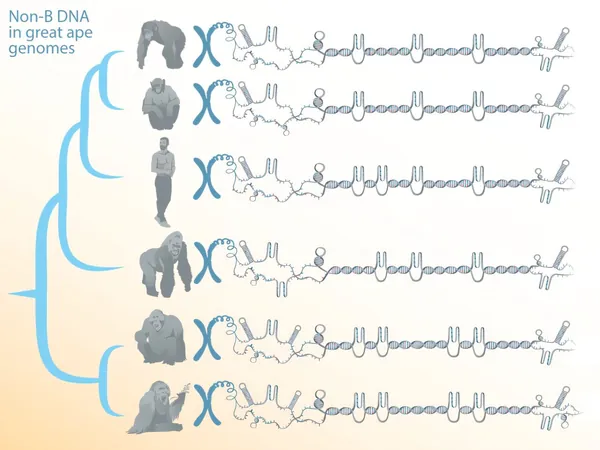
Unlocking the Secrets of Ape DNA: The Surprising World Beyond the Double Helix
2025-04-24
Author: Charlotte
Revolutionary Discoveries in Ape Genomes
Scientists have long understood that the familiar double helix is only one player in the complex game of DNA. Recent groundbreaking research has revealed that certain DNA sequences can adopt alternative structures, termed non-B DNA, which may play crucial roles in cellular functions and genome evolution.
A Game-Changing Study
A dedicated team of biologists from Penn State has made significant strides by identifying these elusive non-B DNA structures across the genomes of great apes for the first time. Their findings could illuminate the complexities behind genetic diseases and cancer, providing a deeper understanding of how these structures influence the genome.
The Power of Telomere-to-Telomere Genomes
This innovative study leveraged cutting-edge telomere-to-telomere (T2T) genome assemblies, a leap forward in sequencing technology that allows researchers to tackle the repetitive DNA that has historically confounded geneticists. With these new insights, the team was able to explore segments of the genome that were previously riddled with gaps, predominantly made up of repetitive sequences.
From Repetitive to Revealed
Historically, the sequencing of genomes relied heavily on short-read technologies that cut DNA into minuscule fragments—like piecing together a complex puzzle with countless identical pieces. However, the T2T approach utilizes longer segments, allowing researchers to access and analyze regions that house potential non-B DNA structures.
Diverse Forms of Non-B DNA Awaits Discovery
This non-B DNA can manifest in various fascinating forms, such as bent DNA, hairpins, G-quadruplexes, and Z-DNA, all linked to specific repetitive motifs. These unique structures may influence crucial processes such as DNA replication, gene expression, and chromosomal stability during cell division.
Connecting the Dots: Non-B DNA and Evolution
The research team meticulously searched the T2T genomes of humans and several ape species, revealing a consistent pattern of non-B motifs. Among the genomes studied, the gorilla exhibited a higher prevalence of these motifs, attributed to its enriched repetitive DNA.
Potential Genetic Risks Ahead?
Interestingly, non-B DNA is associated with higher mutation rates and genomic instability, which can lead to chromosomal rearrangements—an important factor in evolutionary biology and disease. The researchers noted a alarming link between non-B DNA motifs and instances of genetic disorders like Down syndrome, emphasizing the urgent need for further investigation.
A New Perspective on Genomic Functionality
As the study wraps up, it pushes the boundaries of how we perceive genomic function, advocating for the importance of structural DNA characteristics alongside sequence. This research serves as a catalyst for future explorations into the intriguing structures of DNA and their varied roles within the genome. Is this the dawn of a new era in genomic research? Only time—and further studies—will tell.









 Brasil (PT)
Brasil (PT)
 Canada (EN)
Canada (EN)
 Chile (ES)
Chile (ES)
 Česko (CS)
Česko (CS)
 대한민국 (KO)
대한민국 (KO)
 España (ES)
España (ES)
 France (FR)
France (FR)
 Hong Kong (EN)
Hong Kong (EN)
 Italia (IT)
Italia (IT)
 日本 (JA)
日本 (JA)
 Magyarország (HU)
Magyarország (HU)
 Norge (NO)
Norge (NO)
 Polska (PL)
Polska (PL)
 Schweiz (DE)
Schweiz (DE)
 Singapore (EN)
Singapore (EN)
 Sverige (SV)
Sverige (SV)
 Suomi (FI)
Suomi (FI)
 Türkiye (TR)
Türkiye (TR)
 الإمارات العربية المتحدة (AR)
الإمارات العربية المتحدة (AR)